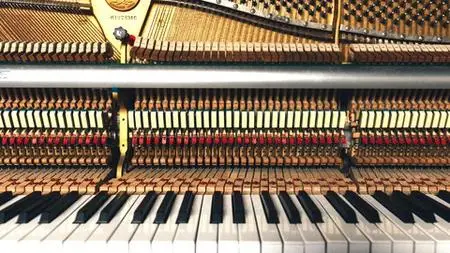Counterpoint Fundamentals
Published 3/2024
MP4 | Video: h264, 1920x1080 | Audio: AAC, 44.1 KHz
Language: English | Size: 6.22 GB | Duration: 3h 50m
Published 3/2024
MP4 | Video: h264, 1920x1080 | Audio: AAC, 44.1 KHz
Language: English | Size: 6.22 GB | Duration: 3h 50m
A practical guide for piano improvisation
What you'll learn
Improvise two-part Inventions
Learn the fundamental principles of harmony
Employ intervals for developing melody and harmony
Invent polyphonic music at the piano
Apply the principles of voice-leading
Improvise coherently with either hand, separated or together
Appreciate counterpoint as a strategy for improvisation and composition
The three main categories of Counterpoint: Homorhythm, Polyphony, Ornament
How to integrate coherently melody and harmony
Requirements
Intermediate Piano Proficiency
Familiarity with major/minor scales
Familiarity with music notation
Description
The goal of the course is to introduce students to the technique of Counterpoint as a way to make music intuitively and creatively.It is a practical course: students will learn through improvisation the principles behind two-part invention and polyphonic voice leading by exploring Counterpoint at the piano.Each module will explore an aspect of Counterpoint: rather than being a presentation of different kinds of Counterpoint, each class adds to the principles discussed in previous classes and guides the student to slowly master them at the piano. By mid-course students can therefore expect a significant raise in the level of complexity: I therefore encourage to practice the material covered in a class extensively before moving on to the following module. Two or three days (2-3 hours of practice) is the minimum time suggested between classes.The course will guide through the 3 main stages of Counterpoint invention: homorhythm, polyphony (counterpoint species), ornamentation. We will start from the theory of Intervals, the principles of effective melodic conduct, the relationship between the parts; we will then start exploring harmonic combinations and improvise appropriately; we will introduce the different species of Counterpoint and investigate the creative boundaries within them; we will discuss best practices and preferred solutions to common problems, by looking at a variety of examples from the existing repertoire; we will explore creative options and develop new musical ideas based on counterpoint principles; in the final modules we will create a full two part invention step by step.The course is intended to music students who have an intermediate proficiency in piano and familiarity with music notation: although much of the course is designed for practical purposes there will be musical examples to read and musical exercises to write.
Overview
Section 1: Course Overview
Lecture 1 Overview
Lecture 2 Fundamentals
Section 2: Two Part Invention: First Steps
Lecture 3 Introduction of the 3rd
Lecture 4 Introduction of the 6th
Lecture 5 Combining 3rd and 6th
Section 3: Creative Intermission n. 1
Lecture 6 Creative Intermission
Section 4: The Music Develops: adding rhythm and other intervals.
Lecture 7 Introduction of Rhythm
Lecture 8 Repertoire Examples
Lecture 9 Last intervals: the 5th and the 8ve
Section 5: The Invention grows. The 2nd Species Counterpoint.
Lecture 10 2nd Species Counterpoint: 2 notes against 1
Lecture 11 Practical strategies for creativity
Section 6: Finalizing your Invention: the Creative Touch
Lecture 12 Creative Intermission n. 2
Lecture 13 Completing a counterpoint, step by step.
Pianists who wish to make music in an intuitive way, by mastering the underlying principles of harmony.,Musicians/students who wish to develop practically their understanding of classical music style composition, as a strong foundation for all other styles.



